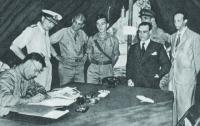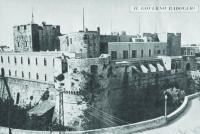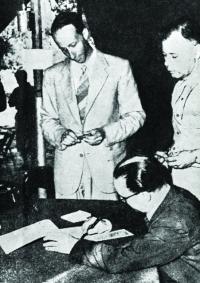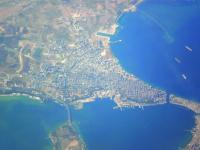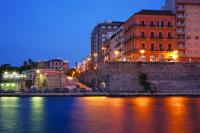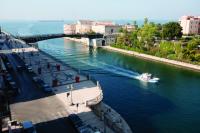THIS WEEK, 70 years ago, elements of the British 8th Army, under the command of Gen. Bernard Law Montgomery, crossed the Strait of Messina, from Sicily to Reggio di Calabria, located on the toe of Italy, to attack, "...the soft underbelly of the Axis," as Churchill described it. The Strait of Messina connects the Tyrrhenian Sea and Ionian Sea, and separates Sicily from the Italian Peninsula. It is 1.9 miles wide at its narrowest point. Near the Sicilian city of Messina, it is 3.2 miles wide. Today the 2,700-year-old city has a population of 250,000.
The operation was ordered against the advice, and over the protests, of General Montgomery. The idea behind the operation was that it would tie down German troops, who would then not be available to contest the Allied landing at Salerno, further up the peninsula. However, General Montgomery did not believe it would achieve that goal, because he did not believe that the Germans would contest the Eighth ArmyÙs landing, and that would mean that his Army would be 300 miles from the primary landings at Salerno and unable to assist or support. "Monty" was correct.
Field Marshal Albert Kesselring, whom Hitler had tasked with the defense of the Italian Peninsula, had decided not to contest the Eighth ArmyÙs landings. Rather, the Field Marshal would concentrate his forces at Salerno and hopefully defeat that landing and then turn his attention to MontyÙs 8th Army. Consequently, what German troops there were, in the area of the British landings, withdrew at the first sign of pressure. Their only resistance to Eighth Army was the destruction of roads and bridges, mines, booby traps and a few ambushes.
On August 31, Generals Giuseppe Castellano and Giacomo Zanussi met Generals Walter Bedell Smith, Kenneth D.W. Strong, Sir Harold Alexander, John K. Cannon and British Ambassador to Algeria, Sir Harold Macmillan at Allied Army Headquarters near Palermo, Sicily to discuss ItalyÙs surrender. After a day of discussions, the Italians flew back to Rome, without an agreement. After another day of discussions, among themselves, the Italians decided to accept the Allied offer. General Castellano returned to Sicily the next day.
British battleships Warspite and Valiant shelled Reggio di Calabria on September 2. The next day, the First Canadian Division, under the command of Major-General Guy G. Simonds - the youngest division commander in the Canadian Army - landed at Cape Spartivento on the southern side of the Italian toe. The Canadians suffered only nine casualties the first day. The British 5th Infantry Division, under the command of Major-General Gerard Bucknall, landed on the north side of the toe.
General Castellano, finally, at 5:15 P.M., that day, executed a Surrender document on behalf of the Kingdom of Italy. General Smith signed for the Allies. This had been in the works since Mussolini had been replaced by Marshal Pietro Bagdolio, in July. General Castellano had surreptitiously traveled to Lisbon, Portugal, to meet with Allied representatives to discuss his countryÙs withdrawal from the war. But der Führer was no fool. He had anticipated Italian perfidy, and had been quietly moving more German units onto the Italian Peninsula.
The only German unit in the area of Eighth ArmyÙs landing was the 15th Panzergrenadier Regiment, which withdrew to Bagnera, about 25 miles from the landings. The next day, the 5th Division reached Bagnera and drove the German regiment out of its fixed positions. Although there was some opposition to 8th ArmyÙs advance, what really slowed the advance was the clearing of mines from the roads and the demolished bridges.
On September 8, at 6:30 P.M., Supreme Allied Commander, General Dwight D. Eisenhower, prematurely, and unexpectedly, announced that the Italian Kingdom had surrendered. German units began to surround Rome.
The following day, the British First Airborne Division, commanded by Major-General George F. Hopkinson, landed, unopposed, at the 3,000 year old port of Taranto, located on the upper part of the heel of the Italian "boot." The Airborne Division was transported to Taranto, not by air, but by ship - British cruisers Aurora, Penelope, Dido, Syrius and the American cruiser, Boise. As the Allied flotilla was approaching Taranto, the Italian battleships Andrea Doria and Caio Duilio and three cruisers were leaving the harbor. This gave the Allied sailors a start, but they were only going to Malta in accord with the Surrender Agreement. Since the Germans had left, there was no resistance from the Italians, and everything went very smoothly. General Hopkinson established his headquarters in the Albergo Europa Hotel, and accepted the Italian surrender.
Allied landings also began at Salerno.
Early that same morning, with the Germans surrounding the Italian capital, Marshal Bagdolio, the Royal Family and members of the government escaped from Rome, in five cars, and made their way to Pescara, on the Adriatic coast, where they were met by a British ship. Eventually, they would disembark at Brindisi, on the lower part of the heel of the Italian "boot," on the Adriatic coast. There, they would establish an Allied-friendly government - of sorts. So, in the north would be MussoliniÙs "government," propped up by the Germans, and in the south would be the Royal/Bagdolio "government," propped up by the Allies! The only power either had was that provided by their "sponsors."
The Airborne Division did not see any action, or Germans, until the day after it landed, when it reached the town of Mottola. There the division ran into an ambush near the town of Castellanetta, in which General Hopkinson was killed by a blast of machine gun fire. He was replaced by Brigadier-General Ernest Down. By September 11, the Division had occupied the ports of Brindisi and Bari, on the upper part of the heel of the Italian "boot," on the Adriatic coast, and had made contact with the First Canadian Infantry Division. By the end of the next day, the First Airborne Division had advanced 20 miles. That same day, SS Captain Otto Skorzeny, with a small band of men, executed a daring rescue of Il Duce from the mountaintop hotel where he had been held captive. Within the week, at HitlerÙs insistence, Il Duce had declared a new fascist "government."
Charles AllfreyÙs V Corps established its headquarters at Taranto on September 18. Four days later, the 78th Infantry Division, commanded by Vyvyan Evelegh, began arriving at Bari. The next day, the 8th Indian Infantry Division, commanded by Major-General Dudley Russell, began arriving at Taranto.
On September 27, the British captured Foggia. Its airfield would allow the Allies to, aerially, dominate southern Europe for the balance of the war. Two days later, aboard the British battleship, HMS Nelson, in Malta harbor, General Eisenhower and Marshal Badoglio signed a more formal agreement. Marshal BadoglioÙs government declared war on its former German ally on October 13, 1943.
When the war ended, almost two years later, Allied troops were still fighting on, "...the soft underbelly of the Axis."
NEXT WEEK: SALERNO
Mr. Wimbrow writes from Ocean City, Maryland, where he practices law representing those persons accused of criminal and traffic offenses, and those persons who have suffered a personal injury through no fault of their own. Mr. Wimbrow can be contacted at
wimbrowlaw@gmail.com.
